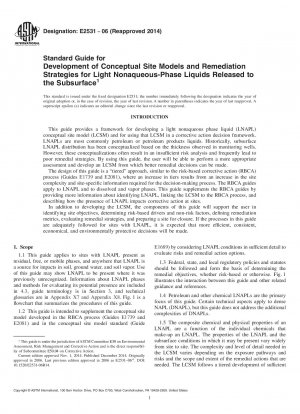ASTM E2531-06(2014)
Standard Guide for Development of Conceptual Site Models and Remediation Strategies for Light Nonaqueous-Phase Liquids Released to the Subsurface
- Standard No.
- ASTM E2531-06(2014)
- Release Date
- 2006
- Published By
- American Society for Testing and Materials (ASTM)
- Status
- Replace By
- ASTM E2531-06(2020)
- Latest
- ASTM E2531-06(2020)
- Scope
5.1 This guide will help users answer simple and fundamental questions about the LNAPL occurrence and behavior in the subsurface. It will help users to identify specific risk-based drivers and non-risk factors for action at a site and prioritize resources consistent with these drivers and factors.
5.2 The site management decision process described in this guide includes several features that are only examples of standardized approaches to addressing the objectives of the particular activity. For example, Table 1 provides example indicators of the presence of LNAPL. Table 1 should be customized by the user with a modified list of LNAPL indicators as technically appropriate for the site or group of sites being addressed.
5.3 This guide advocates use of simple analyses and available data for the LCSM in Tier 1 to make use of existing data and to interpret existing data potentially in new ways. The Tier 1 LCSM is designed to identify where additional data may be needed and where decisions can be made using existing data and bounding estimates.
5.4 This guide expands the LCSM in Tier 2 and Tier 3 to a detailed, dynamic description that considers three-dimensional plume geometry, chemistry, and fluxes associated with the LNAPL that are both chemical- and location-specific.
5.5 This guide fosters effective use of existing site data, while recognizing that information may be only indirectly related to the LNAPL body conditions. This guide also provides a framework for collecting additional data and defining the value of improving the LCSM for remedial decisions.
5.6 By defining the key components of the LCSM, this guide helps identify the framework for understanding LNAPL occurrence and behavior at a site. This guide recommends that specific LNAPL site objectives be identified by the user and stakeholders and remediation metrics be based on the LNAPL site objectives. The LNAPL site objectives should be based on a variety of issues, including:
5.6.1 Potential human health risks and risks to relevant ecological receptors and habitats;
5.6.2 Specific regulatory requirements; and
5.6.3 Aesthetic or other management objectives.
5.7 This guide provides a framework by which users specify benefit remediation metrics that are consistent and achievable given the conditions of the LCSM.
5.8 Guidance is focused on the information needed to make sound decisions rather than specific methods or evaluations that might be used in deriving that information. This guide is weighted toward field data rather than modeling, though modeling is clearly recognized as a useful tool in generating scenarios and bracketing conditions of the LNAPL body conditions. Limited examples of site specific data used to develop the LCSM are provided in
ASTM E2531-06(2014) Referenced Document
- ASTM D5717 Standard Guide for Design of Ground-Water Monitoring Systems in Karst and Fractured-Rock Aquifers
- ASTM D6235 Standard Practice for Expedited Site Characterization of Vadose Zone and Ground Water Contamination at Hazardous Waste Contaminated Sites
- ASTM D653 Standard Terminology Relating to Soil, Rock, and Contained Fluids
- ASTM E1689 Standard Guide for Developing Conceptual Site Models for Contaminated Sites
- ASTM E1739 Standard Guide for Risk-Based Corrective Action Applied at Petroleum Release Sites
- ASTM E1903 Standard Guide for Environmental Site Assessments: Phase II Environmental Site Assessment Process
- ASTM E1912 Standard Guide for Accelerated Site Characterization for Confirmed or Suspected Petroleum Releases
- ASTM E1943 Standard Guide for Remediation of Ground Water by Natural Attenuation at Petroleum Release Sites
- ASTM E2081 Standard Guide for Risk-Based Corrective Action
- ASTM E2091 Standard Guide for Use of Activity and Use Limitations, Including Institutional and Engineering Controls
- ASTM E2205 Standard Guide for Risk-Based Corrective Action for Protection of Ecological Resources
- ASTM E2348 Standard Guide for Framework for a Consensus-based Environmental Decision-making Process
ASTM E2531-06(2014) history
- 2020 ASTM E2531-06(2020) Standard Guide for Development of Conceptual Site Models and Remediation Strategies for Light Nonaqueous-Phase Liquids Released to the Subsurface
- 2006 ASTM E2531-06(2014) Standard Guide for Development of Conceptual Site Models and Remediation Strategies for Light Nonaqueous-Phase Liquids Released to the Subsurface
- 2006 ASTM E2531-06e1 Standard Guide for Development of Conceptual Site Models and Remediation Strategies for Light Nonaqueous-Phase Liquids Released to the Subsurface
- 2006 ASTM E2531-06 Standard Guide for Development of Conceptual Site Models and Remediation Strategies for Light Nonaqueous-Phase Liquids Released to the Subsurface

Copyright ©2024 All Rights Reserved